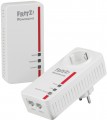Wired speed
The maximum wired speed supported by the adapter.
When choosing according to this indicator, note that manufacturers usually indicate the theoretical maximum in the specifications. In fact, the wired speed can be noticeably lower (in particular, due to interference in the mains). In addition, it may be limited by other factors: for example, if the adapter has only one 100 Mbps Fast Ethernet port, then its actual bandwidth cannot exceed 100 Mbps, even if the specifications indicate a wired speed of 500 Mbps .
Nevertheless, the higher the claimed speed (
1 Gbps), the higher the practical one, all other things being equal. So for tasks related to the transfer of large amounts of data or requiring a quick response (watching/broadcasting high-definition video, working with torrents, online games), you should choose the “faster” models.
Range
The maximum distance at which the adapter provides reliable data transmission over the mains wires; in other words, the longest length of electrical wires between the adapter and another Powerline device that maintains a good connection.
Note that manufacturers usually indicate the coverage radius for perfect conditions (high-quality wiring with minimal resistance, no interference, etc.), which are far from always found in real applications. Therefore, the actual coverage radius is often less than the claimed one, and it is worth choosing an adapter according to this indicator with a certain margin. However, even the most modest modern models provide a range of about 150 m, and in the most advanced it can be 300 m or more — this is quite enough not only for an apartment or house, but also for a fairly large office space.
LAN
The number of output connectors provided in the adapter design.
There are LAN ports with different bandwidth. So Fast Ethernet provides data transfer rates up to
100 Mbps ; such indicators are quite enough for most simple tasks and even for watching high-definition video in streaming mode. At the same time, as technology develops, this standard is gradually losing ground to the more advanced Gigabit Ethernet at speeds up to
1 Gbps. This option can be especially useful for transferring large amounts of information, as well as in cases where several network devices are connected to one port at once.
The presence
of several Ethernet connectors allows you to simultaneously connect several devices to the adapter (for example, a PC, a printer and a network TV) without the use of routers and other additional equipment. Also note that one set may include adapters with a different number of connectors. As a rule, in such cases, one device has 1 network port and works “at the input” (for example, an Ethernet cable from the provider is connected to it), the remaining adapters act as switches for several devices.

